Common bamboo
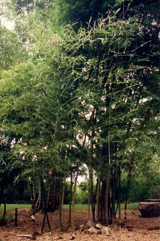
A tropical plant. It grows throughout the tropics and subtropics. It grows up to 1,200 m altitude. It does best at low altitudes. It can stand frost down to -3°C. It has been introduced to PNG and is common in the lowlands. (A different large bamboo is grown and eaten in the highlands of Papua New Guinea.) In the Cairns Botanical Gardens. In XTBG Yunnan. It suits hardiness zones 9-12.
Also known as:
Aundmi, Awi ampel, Bachiabas, Bakal, Bamboo, Bambu kuning, Basini bans, Buera bueta, Buloh kuning, Buloh minyak, Daisan-chiku, Domar, Hatu mad, Jaibaru wa, Jajang ampel, Jajang gading, Kabaloan, Kamaundmi, Kauayan-kiling, Murangi, Obros kunbuntol, Pai mai, Pau, Phai-bongkham, Phai-luang, Po-o, Pring ampel, Pring legi, Pring tutul, Rabuang, Ranai-shilot, Robung, Russei kaew, S'ang kh'am, Shwe-wa, Sunderkania bans, Tamelang, Tatem, Tutu, Uasur, Vadud, Vairua, Wanet
Synonyms
- Bambusa thouarsii Kunth.
- Bambusa surinamensis Ruprecht
- Leleba vulgaris (Schrader ex Wendland) Nakai
Edible Portion
- Shoots
Where does Common bamboo grow?
Found in: Africa, America, Asia, Australia, Bangladesh, British Indian Ocean Terr., BIOT, Burkina Faso, Cambodia, Cameroon, Canada, Central Africa, Central African Republic, CAR, Central America, China, Congo DR, Costa Rica, Côte d'Ivoire, Dominican Republic, East Africa, East Timor, Fiji, Gabon, Ghana, Grenada, Guam, Guinea, Guinée, Guinea-Bissau, Guyana, Haiti, Hawaii, Himalayas, India, Indochina, Indonesia, Ivory Coast, Kenya, Kiribati, Laos, Madagascar, Malawi, Malaysia, Marquesas, Micronesia, Mozambique, Myanmar, Nauru, Nepal, Nigeria, Northeastern India, Pacific, Palau, Papua New Guinea, PNG, Philippines, Rotuma, SE Asia, Senegal, Sierra Leone, Southern Africa, South America, Sri Lanka, St. Kitts and Nevis, Sudan, Tanzania, Thailand, Timor-Leste, Tonga, Uganda, United States, Vanuatu, Vietnam, West Africa, West Indies, Yap, Zambia
Notes: There are about 120 Bambusa species. They are tropical and subtropical in Asia. Chemical composition of young shoots per 100 g edible portion: Water 88-90 g, Protein 1.8-2.6 g, Fat 4.1-7.2 g, Carbohydrates 0-0.4 g, Fibre 1.1-1.2 g, Ash 0.8-0.9 g, Ca 22.8-28.6 mg, P 27.5-37 mg, Fe 1.1-1.4 mg, Vitamin C 0-3.1 mg,
Status: The plant is widespread in Papua New Guinea and is important for building. As a food plant it is only of minor importance. It is a cultivated plant.
Growing Common bamboo
Cultivation: It is easily grown by planting cut portions of the green stalks. It can also be grown from shoots off the rhizome or underground stem and from branches.
Edible Uses: The very young shoots are cooked and eaten. The shoots are bitter. They are cooked, or added to soups and made into pickles.
Production: Offsets can produce mature clumps in 7 years. They grow very quickly. Haulms can grow 4 m high in 2 weeks.
Nutrition Info
per 100g edible portion| Edible Part | Energy (kcal) | Protein (g) | Iron (mg) | Vitamin A (ug) | Vitamin c (mg) | Zinc (mg) | % Water |
|---|---|---|---|---|---|---|---|
| Shoots | 17 | 2.5 | - | - | - | - |
Common bamboo Photos

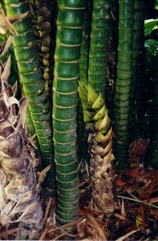
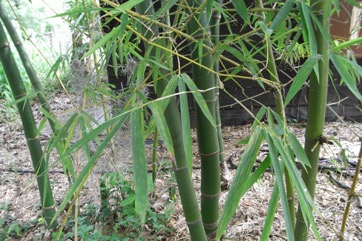
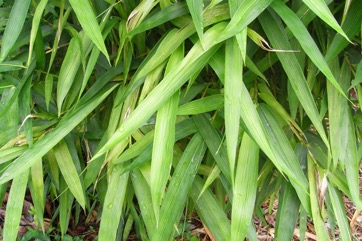
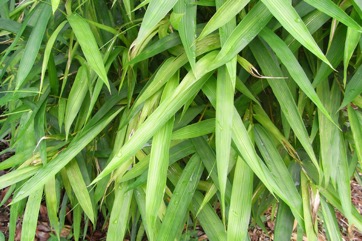
References
Ambasta S.P. (Ed.), 2000, The Useful Plants of India. CSIR India. p 67
Anderson, E. F., 1993, Plants and people of the Golden Triangle. Dioscorides Press. p 203
Ashton, M. S., et al 1997, A Field Guide to the Common Trees and Shrubs of Sri Lanka. WHT Publications Ltd. p 72
Bandyopadhyay, S. et al, 2009, Wild edible plants of Koch Bihar district, West Bengal. Natural Products Radiance 8(1) 64-72
Bircher, A. G. & Bircher, W. H., 2000, Encyclopedia of Fruit Trees and Edible Flowering Plants in Egypt and the Subtropics. AUC Press. p 53
Borrell, O.W., 1989, An Annotated Checklist of the Flora of Kairiru Island, New Guinea. Marcellin College, Victoria Australia. p 22
Brink, M., 2008. Bambusa vulgaris Schrad. ex J.C.Wendl. [Internet] Record from Protabase. Louppe, D., Oteng-Amoako, A.A. & Brink, M. (Editors). PROTA (Plant Resources of Tropical Africa / Ressources végétales de l’Afrique tropicale), Wageningen, Netherlands. < http://database.prota.org/search.htm>. Accessed 14 October 2009.
Burkill, H. M., 1985, The useful plants of west tropical Africa, Vol. 2. Kew.
Burkill, I.H., 1966, A Dictionary of the Economic Products of the Malay Peninsula. Ministry of Agriculture and Cooperatives, Kuala Lumpur, Malaysia. Vol 1 (A-H) p 302
Cabalion, P. and Morat, P., 1983, Introduction le vegetation, la flore et aux noms vernaculaires de l'ile de Pentcoste (Vanuatu), In: Journal d'agriculture traditionnelle et de botanique appliquee JATBA Vol. 30, 3-4
Chandrakumar, P., et al, 2015, Ethnobotanical studies of wild edible plants of Gond, Halba and Kawar tribes of Salekasa Taluka, Gondia District, Maharashtra State, India. International Research Journal of Pharmacy 6(8)
Coll. pl. 2:26, t. 47. 1808
Cowie, I, 2006, A Survey of Flora and vegetation of the proposed Jaco-Tutuala-Lore National Park. Timor-Lests (East Timor) www.territorystories.nt/gov.au p 52
Crouzet, I., Starosta, P., 1998, Bamboos. Evergreen. p 20
Cundall, P., (ed.), 2004, Gardening Australia: flora: the gardener's bible. ABC Books. p 217
Dey, A. & Mukhererjee, A., 2015, Living and Survival Amidst Hunger: Wild Edible Botanicals as a Prime Forest Productivity in the Rural Purulia District, West Bengal, India from Colonial to Present. Research Journal of Forestry 9(3): 71-86
Dharani, N., 2002, Field Guide to common Trees & Shrubs of East Africa. Struik. p 198
Dransfield, S. & Widjaja, EA., 1995, Plant Resources of South East Asia. PROSEA No. 7 Bamboos. Leiden. p 75
Etherington, K., & Imwold, D., (Eds), 2001, Botanica's Trees & Shrubs. The illustrated A-Z of over 8500 trees and shrubs. Random House, Australia. p 114
Facciola, S., 1998, Cornucopia 2: a Source Book of Edible Plants. Kampong Publications, p 46 (As Leleba vulgaris)
Fowler, D. G., 2007, Zambian Plants: Their Vernacular Names and Uses. Kew. p 87
Franklin, J., Keppel, G., & Whistler, W., 2008, The vegetation and flora of Lakeba, Nayau and Aiwa Islands, Central Lau Group, Fiji. Micronesica 40(1/2): 169–225, 2008
French, B.R., 1986, Food Plants of Papua New Guinea, Asia Pacific Science Foundation p 133
Friday, J. B., 2005, Forestry and Agroforestry Trees of East Timor. http://www.ctahr.hawaii.edu/forestry/data/Timor/Timor trees.html (var. vittata)
Haberle, S., 2005, Ethnobotany of the Tari basin, Southern Highlands Province, Papua New Guinea. Palaeoworks Technical Paper 6.
Hani Medicine of Xishuangbanna, 1999, p 431
Hu, Shiu-ying, 2005, Food Plants of China. The Chinese University Press. p 286
Kumar, R. & Saikia, P., 2020, Wild edible plants of Jharkhand and their utilitarian perspectives. Indian Journal of Traditional Knowledge Vol 19 (2), April 2020, pp 237-250
Latham, P., 2004, Useful Plants of Bas-Congo province. Latham & DFID p 47
Latham, P. & Mbuta, A. K., 2014, Useful Plants of Bas-Congo Province, Democratic Republic of Congo. Volume 1. Salvation Army. p 69
Latham, P. & Mbuta, A. K., 2017, Plants of Kongo Central Province, Democratic Republic of Congo. Volume 1. 3rd ed p 75
Leach, G. J., 1988, Bush Food Plants of the Blackwater and Karawari Rivers Area, East Sepik Province, Papua New Guinea. Science in New Guinea 14(2). p 9
Martin, F.W. & Ruberte, R.M., 1979, Edible Leaves of the Tropics. Antillian College Press, Mayaguez, Puerto Rico. p 194, 25
Monsalud, M.R., Tongacan, A.L., Lopez, F.R., & Lagrimas, M.Q., 1966, Edible Wild Plants in Philippine Forests. Philippine Journal of Science. p 476
Norrington, L., & Campbell, C., 2001, Tropical Food Gardens. Bloomings Books. p
Ochse, J.J. et al, 1931, Vegetables of the Dutch East Indies. Asher reprint. p 305
Omawale, 1973, Guyana's edible plants. Guyana University, Georgetown p 81
Pawera, L., et al, 2020, Wild Food Plants and Trends in Their Use: From Knowledge and Perceptions to Drivers of Change in West Sumatra, Indonesia, Foods. 2020, 9, 1240
Peekel, P.G., 1984, (Translation E.E.Henty), Flora of the Bismarck Archipelago for Naturalists, Division of Botany, Lae, PNG. p 55,
Phon, P., 2000, Plants used in Cambodia. © Pauline Dy Phon, Phnom Penh, Cambodia. p 87
Plants of Haiti Smithsonian Institute http://botany.si.edu/antilles/West Indies
Premlata, T., et al, 2020, Edible bamboo resources of Manipur: consumption pattern of young shoots, processing techniques and their commercial status in the local market. Indian Journal of Traditional Knowledge Vol. 19(1) pp 73-82
Purseglove, J.W., 1972, Tropical Crops. Monocotyledons. Longmans p 132
Singh, P., et al, 2019 Plants of Indian Himalayan region. Part 1 Botanical Surbey of India. p 32
Smith, A.C., 1979, Flora Vitiensis Nova, Lawaii, Kuai, Hawaii, Volume 1 p 295
Solomon, C., 2001, Encyclopedia of Asian Food. New Holland. p 17
Staples, G.W. and Herbst, D.R., 2005, A tropical Garden Flora. Bishop Museum Press, Honolulu, Hawaii. p 743 (Drawing)
Sukarya, D. G., (Ed.) 2013, 3,500 Plant Species of the Botanic Gardens of Indonesia. LIPI p 839
Tanaka, Y & Van Ke, N., 2007, Edible Wild Plants of Vietnam. Orchid Press. p 118
Topp, J. M. W., 1988, An Annotated Check List of the Flora of Diego Garcia, British Ocean Territory. Atoll Research Bulletin No. 313 (Rare)
van Wyk, B., 2005, Food Plants of the World. An illustrated guide. Timber press. p 174
Williamson, J., 2005, Useful Plants of Malawi. 3rd. Edition. Mdadzi Book Trust. p 34
Woodward, P., 2000, Asian Herbs and Vegetables. Hyland House. p 27
World Checklist of Useful Plant Species 2020. Royal Botanic Gardens, Kew
Yuncker, T.G., 1959, Plants of Tonga, Bernice P. Bishop Museum, Hawaii, Bulletin 220. p 52
Zuchowski W., 2007, Tropical Plants of Costa Rica. A Zona Tropical Publication, Comstock Publishing. p 147